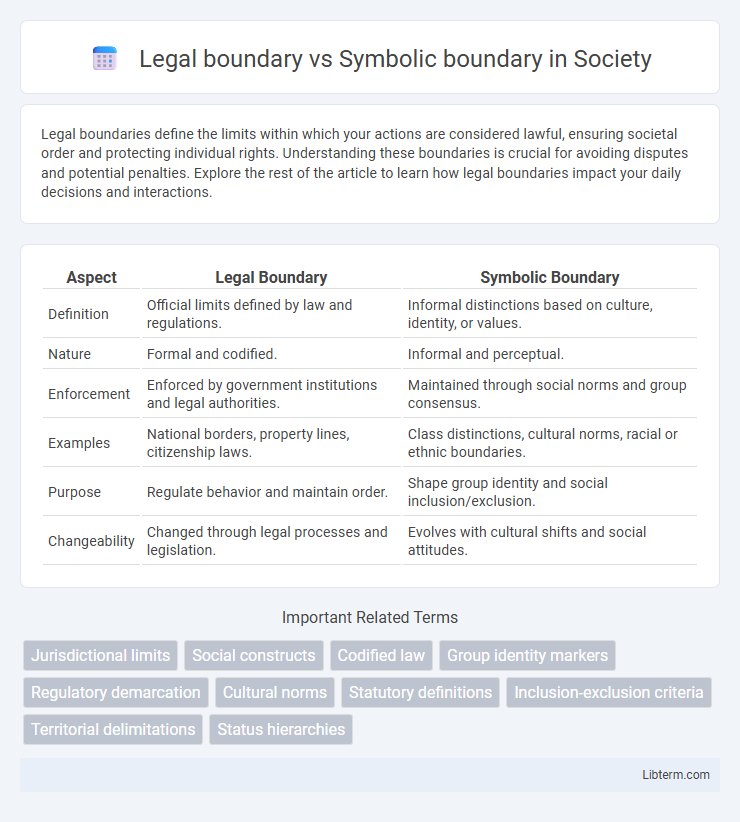Legal boundaries define the limits within which your actions are considered lawful, ensuring societal order and protecting individual rights. Understanding these boundaries is crucial for avoiding disputes and potential penalties. Explore the rest of the article to learn how legal boundaries impact your daily decisions and interactions.
Table of Comparison
| Aspect | Legal Boundary | Symbolic Boundary |
|---|---|---|
| Definition | Official limits defined by law and regulations. | Informal distinctions based on culture, identity, or values. |
| Nature | Formal and codified. | Informal and perceptual. |
| Enforcement | Enforced by government institutions and legal authorities. | Maintained through social norms and group consensus. |
| Examples | National borders, property lines, citizenship laws. | Class distinctions, cultural norms, racial or ethnic boundaries. |
| Purpose | Regulate behavior and maintain order. | Shape group identity and social inclusion/exclusion. |
| Changeability | Changed through legal processes and legislation. | Evolves with cultural shifts and social attitudes. |
Introduction to Legal and Symbolic Boundaries
Legal boundaries define explicit, formally recognized limits set by laws and regulations that govern behavior within societies, establishing clear rights and responsibilities. Symbolic boundaries, in contrast, represent social distinctions created through cultural practices, values, and perceptions that separate groups based on identity, status, or beliefs. Understanding both legal and symbolic boundaries is crucial for analyzing how societies regulate interaction and maintain social order beyond formal legislation.
Defining Legal Boundaries
Legal boundaries are formally established by laws, regulations, and official documents to delineate property lines, jurisdictional areas, or rights, providing clear and enforceable limits. Symbolic boundaries, in contrast, represent social, cultural, or psychological distinctions that signify group identities or social status without legal enforcement. Defining legal boundaries involves precise measurement, documentation, and recognition by authorized entities to ensure clarity, legitimacy, and dispute resolution.
Defining Symbolic Boundaries
Symbolic boundaries refer to the conceptual distinctions that groups create to categorize people, behaviors, and objects, shaping social identities and group membership. These boundaries are expressed through cultural symbols, language, rituals, and norms, influencing perceptions of inclusion and exclusion within communities. Unlike legal boundaries defined by formal laws and regulations, symbolic boundaries operate through shared meanings and social practices that guide everyday interactions.
Historical Context of Boundaries
Legal boundaries are officially recognized divisions established through laws and governmental authority, historically used to delineate territories, property rights, and political jurisdictions. Symbolic boundaries, emerging from cultural, social, and ethnic distinctions, have historically shaped group identities and social segregation beyond formal legal demarcations. Both types of boundaries have influenced historical conflicts, migration patterns, and the formation of nation-states by defining where power, rights, and membership apply.
Key Differences Between Legal and Symbolic Boundaries
Legal boundaries are formally established and enforced through laws, regulations, or official decrees, defining clear physical or jurisdictional limits such as property lines, national borders, or zoning districts. Symbolic boundaries, by contrast, are socially constructed distinctions that separate groups based on cultural, religious, or ideological differences, often manifesting in identity, customs, or social norms without legal enforcement. The key difference lies in legal boundaries' objective, codified nature versus symbolic boundaries' subjective, fluid interpretation shaped by collective perception and social meaning.
Social Functions of Symbolic Boundaries
Symbolic boundaries shape group identities by distinguishing insiders from outsiders through cultural markers such as language, rituals, and dress, reinforcing social cohesion and shared values. Unlike legal boundaries, which establish formal jurisdictional limits, symbolic boundaries operate informally to regulate social interactions and maintain social order within communities. These boundaries influence social inclusion, status hierarchies, and collective identity, playing a critical role in sustaining group solidarity and cultural differentiation.
Enforcement and Consequences of Legal Boundaries
Legal boundaries are formally established and enforced by government institutions through laws, regulations, and official sanctions, ensuring compliance through penalties such as fines, imprisonment, or loss of rights. Symbolic boundaries, by contrast, are socially constructed distinctions maintained through cultural norms, identity markers, and social practices without formal legal enforcement or codified penalties. Enforcement of legal boundaries relies on institutional mechanisms and judicial systems, making violations subject to legally binding consequences, while symbolic boundary transgressions often result in social disapproval or exclusion rather than legal punishment.
Overlaps and Interactions Between the Two
Legal boundaries define formal, state-sanctioned limits on property, rights, and responsibilities, while symbolic boundaries represent social or cultural distinctions that influence group identity and inclusion. Overlaps occur when legal definitions reinforce or challenge symbolic groupings, such as zoning laws impacting community cohesion or immigration policies shaping cultural integration. Interactions between these boundaries affect social dynamics by legitimizing certain identities legally or marginalizing others symbolically, ultimately shaping societal structure and individual experiences.
Case Studies Illustrating the Distinction
Case studies in sociology and law reveal how legal boundaries, defined by formal regulations and enforceable rules, differ from symbolic boundaries, which are socially constructed distinctions influencing group identity and cultural meaning. For example, research on caste in India shows how legal reforms abolished caste-based discrimination as a legal boundary, yet symbolic boundaries persist through social customs and practices. Similarly, segregation laws in the United States were legally dismantled, but symbolic boundaries remain visible in residential patterns and social networks.
Implications for Policy and Social Cohesion
Legal boundaries define formal rules and rights established by governments, shaping access to resources and citizenship status, whereas symbolic boundaries represent social distinctions rooted in identity, culture, and perceived group differences. Policies that overlook symbolic boundaries risk exacerbating social divisions and marginalization, as legal equality alone cannot bridge deep-seated cultural and identity gaps. Effective policy frameworks must integrate recognition of symbolic boundaries to promote social cohesion, ensuring that legal inclusion translates into meaningful social integration and trust.
Legal boundary Infographic

 libterm.com
libterm.com